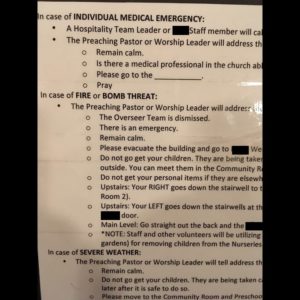Church Security – We Can’t Be Naive
“We can’t be naïve anymore,” said Carl Nelson, speaking to MPR in the wake of recent church shootings in Sutherland, Nashville and Charleston. In the past week many church leaders are double checking their security plans, or if they don’t have plans in place they are realizing that they need to have a plan.
Many churches report that they do have security plans in place. Some churches have uniformed law enforcement, but most utilize volunteers who act as greeters and ushers to be the first ones to notice any sign of danger of emergency situation. Many churches acknowledge that they rely upon members who have conceal and carry permits to be part of their security plan.
However insurance companies and legal experts warn that the use of armed security should be thought through carefully. Using volunteer, armed security raises the risk of “claims for the use of excessive force, and an increased burden for ensuring that all guards are properly screened, trained, and supervised,” says Guide One insurance company in their printed safety guide.
Insurance providers have great resources to help churches create their own security plans and to evaluate their plans. Following the Sutherland shootings several insurers emailed their written emergency plans to their church clients and offered additional assistance in developing a security plan.
In an online article at Christianity Today Police Officer Andrew Mills shared basic advice on how church leaders can reduce risk when confronted with an active shooter:

- Work with local police
- Create a survey of your facility for police
- Create a lock down policy
- Prevent the incident
It is also important that churches “develop strong relationships with law enforcement in your community,” wrote Ed Stetzer in Christianity Today, describing the steps that churches should take to improve their security. Another important step is to have a plan in place and to train volunteers – especially greeters and ushers – how to follow the plan.
“A great example is a local church that has an emergency response placard taped to their pulpit,” said Carl Nelson. “It gives simple, exact commands for the pastor to say in the event of a medical emergency, fire, bomb threat or other immediate danger.”

